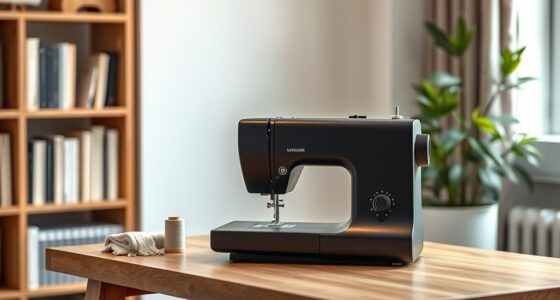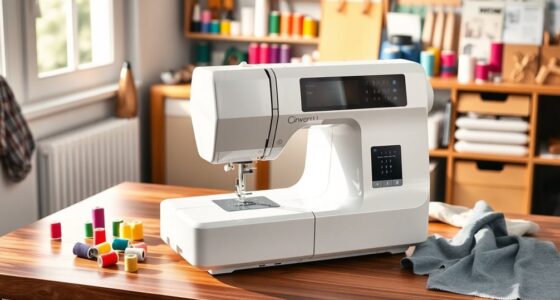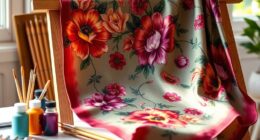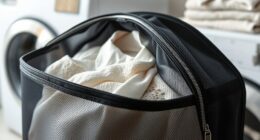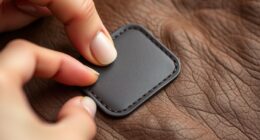If you’re looking to improve your quilting skills, I recommend the top six stitch regulators for beginners. These include guides like the Guidelines4Quilting Quilt Ruler Upgrade Kit, thread tension regulators such as the Sewing Machine Thread Tension Regulator Set, vintage-compatible options like the Singer 29K Part#82188 and #82230, and presser feet like the Ultimate Quilt N Stitch. Each tool helps you achieve even stitches and better control. Keep exploring, and you’ll find ways to make your quilting projects look professional with ease.
Key Takeaways
- Top stitch regulators designed for beginners simplify free-motion quilting with adjustable stitch control and easy installation.
- Compatibility with various machine types ensures accessible options for different quilting setups.
- Features like built-in guides and upgrade kits help achieve precise, even stitches effortlessly.
- Durable materials and user-friendly adjustments enhance long-term reliability and ease of use.
- These picks improve quilting accuracy and confidence, making professional-looking projects achievable for novices.
Complete Guide to Machine Quilting: How to Use Your Sewing Machine for Hand-Quilting Effects
If you’re new to machine quilting and want to achieve the look of hand-quilting, quilting stitch regulators are an excellent tool to contemplate. They help control your stitches, making free-motion quilting more consistent and easier to manage. Using a stitch regulator can boost your confidence, especially when moving between motifs or resizing designs. They’re particularly helpful for beginners, providing guidance and reducing the trial-and-error process. I recommend exploring different types to find one that fits your machine and style. With a stitch regulator, you’ll find it simpler to create even, hand-quilted effects that elevate your projects.
Best For: beginners and quilters seeking consistent, hand-quilting effects on their home sewing machines, especially those interested in controlling stitches and enhancing free-motion quilting skills.
Pros:
- Helps maintain even stitches for a more professional, hand-quilted appearance
- Boosts confidence and reduces trial-and-error, making free-motion quilting easier for beginners
- Compatible with various machine types and styles, offering versatile control
Cons:
- Can be an additional expense, especially for specialized or advanced models
- May require some time to learn and properly calibrate for optimal use
- Not all sewing machines are compatible with stitch regulators, limiting options for some users
Guidelines4Quilting Quilt Ruler Upgrade Kit
The Guidelines4Quilting Quilt Ruler Upgrade Kit is an excellent choice for quilters who want precise, versatile cuts with their 12-inch and 24-inch rulers. Designed for sizes like 12 1/2-inch and 24 1/2-inch, it allows accurate strip and square cuts in 1/8-inch increments, surpassing slotted rulers limited to larger cuts. The kit includes fabric guides, grip strips, and textured strips to secure rulers firmly in place, reducing slipping and waste. It’s user-friendly for both right- and left-handed quilters, improving speed and accuracy. While some find it less effective with certain fabrics, many praise its ability to enhance precision and streamline the quilting process.
Best For: quilters seeking precise, versatile, and speed-enhancing upgrades for their 12-inch and 24-inch rulers, including both beginners and experienced crafters.
Pros:
- Enables accurate strip and square cuts in 1/8-inch increments, offering greater flexibility than traditional slotted rulers
- Includes multiple guides and grip strips to secure rulers firmly, reducing slipping and waste
- User-friendly design suitable for both right- and left-handed quilters, improving speed and accuracy
Cons:
- Some users report that the guides may still slip on certain fabrics or with specific ruler brands
- Plastic components can appear flimsy and may not be as durable over time
- Higher price point compared to basic rulers and accessories, with mixed reviews on overall effectiveness
Sewing Machine Thread Tension Regulator Set
The Sewing Machine Thread Tension Regulator Set is an excellent choice for beginners seeking reliable and easy-to-use accessories to improve their sewing projects. This set helps seamlessly adjust thread tension, ensuring a perfect finish every time. Made with durable, brightly colored materials, it’s both sturdy and visually easy to handle. Compatible with most household sewing machines, it offers versatile support for various sewing tasks. Its compact design makes it portable and convenient for on-the-go adjustments. With smooth operation and reduced work fatigue, this set enhances sewing quality and consistency. Overall, it’s a practical addition to any beginner’s toolkit, boosting confidence in your craft.
Best For: Beginners and DIY sewing enthusiasts seeking a reliable, easy-to-use thread tension adjustment tool compatible with most household sewing machines.
Pros:
- Seamlessly adjusts thread tension for professional-looking finishes
- Made from durable, brightly colored materials for easy handling and visibility
- Compact and portable design ideal for on-the-go sewing adjustments
Cons:
- May require some initial familiarization for precise tension control
- Compatibility might vary with certain specialized or older sewing machine models
- Limited to tension regulation, not a complete sewing machine repair or upgrade kit
SINGER 29K STITCH REGULATOR WITH ADJUSTING SCREW PART#82188
Designed for those seeking precise stitch control, the SINGER 29K Stitch Regulator with Adjusting Screw (Part#82188) offers adjustable settings that help beginners maintain consistent stitches. Its compact size of 3.5 inches square makes it easy to handle and install on compatible sewing machines. While some users report confusion due to limited instructions, the product provides customizable control over stitch regulation. Available from December 17, 2024, it’s not discontinued and is priced variably across stores. With a modest market ranking and an average rating of 3.8 stars, it’s a niche yet useful tool for quilters aiming for improved stitch consistency.
Best For: hobbyist sewists and quilters seeking adjustable stitch control to enhance stitch consistency on compatible sewing machines.
Pros:
- Provides customizable control over stitch regulation for improved sewing precision
- Compact size (3.5 x 3.5 x 1 inches) for easy handling and installation
- Supports sewing projects that require consistent, even stitches, especially for quilting
Cons:
- Limited instructions may cause confusion for first-time users
- Price varies across stores, potentially affecting affordability
- Niche market presence with a modest sales rank, indicating limited mainstream availability
Singer 29K Stitch Regulator GIB Part#82230
If you’re new to quilting and want a reliable stitch regulator, the Singer 29K Stitch Regulator GIB Part#82230 is a solid choice, especially for those working with vintage Singer 29K machines. Made by Sharp Sewing, it measures 3.5 inches square and fits well after some adjustments, as some users reported. It has a solid 4-star rating based on customer feedback. Widely available online, it’s not discontinued and comes with a warranty. While a few have needed to modify the fit, once set up properly, it functions effectively to help you achieve consistent stitches and improve your quilting craft.
Best For: quilting enthusiasts working with vintage Singer 29K machines seeking a reliable stitch regulator to improve stitch consistency.
Pros:
- Compatible with vintage Singer 29K machines, making it ideal for restoring or upgrading older equipment
- Widely available online with a solid 4-star customer rating, indicating reliable performance
- Comes with a warranty and is designed to help achieve uniform stitches for better quilting results
Cons:
- Some users have reported fit issues requiring filing or modification for proper installation
- Slightly larger dimensions (3.5 inches square) may necessitate adjustments to fit certain machine models
- Price varies by seller and location, which could impact affordability for some buyers
The Ultimate Quilt N Stitch Presser Foot
For beginners looking to achieve precise, evenly spaced parallel stitches, the Ultimate Quilt N Stitch Presser Foot is an excellent choice. It’s designed specifically for straight-line quilting and features a built-in stitch alignment ruler that guides you effortlessly. The adjustable guide, ranging from 3/8 inch to 3 inches, allows customization for different projects, making multiple rows of stitching simple and accurate. Compatible with low shank sewing machines, this presser foot eliminates the need for marking lines, saving time and reducing errors. Its ease of use and precision make it a favorite for quilters aiming for professional-looking results with minimal effort.
Best For: beginners and quilters seeking precise, evenly spaced straight-line stitching and quilting with minimal marking required.
Pros:
- Built-in stitch alignment ruler ensures accurate parallel stitching.
- Adjustable guide from 3/8 inch to 3 inches allows versatile project customization.
- Compatible with low shank sewing machines, broadening its usability.
Cons:
- May require some initial practice to perfect guiding techniques.
- Not suitable for decorative or free-motion quilting styles.
- Limited to straight-line stitching, so not versatile for other stitch types.
Factors to Consider When Choosing Quilting Stitch Regulators for Beginners
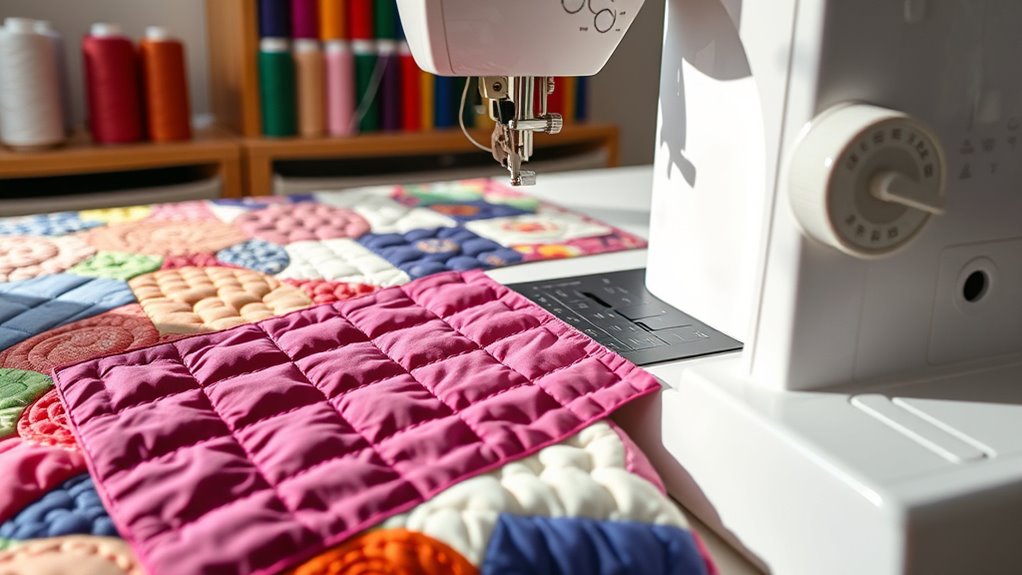
When selecting quilting stitch regulators, I focus on how well they match my machine’s specifications and features. I also consider how easy they are to install and use, along with their durability and overall value. These factors help me choose the right regulator that fits my needs and budget.
Compatibility With Machine
Choosing a quilting stitch regulator that works well with your machine starts with checking its compatibility. First, verify the regulator matches your machine’s make and model, as some are designed for specific brands or types. Check your machine’s shank type—low, high, or slant—and confirm the regulator fits this configuration for proper operation. Review the stitch length adjustments supported by the regulator to make sure they meet your quilting needs. Additionally, see if you need any adapters or accessories, especially for older or less common machines. Ease of installation is important too; confirm that the regulator’s mounting system is compatible with your machine’s presser foot and needle area. Taking these steps helps prevent frustration and ensures smooth quilting sessions.
Adjustability Features
Adjustability features are essential for beginners because they let you customize stitch spacing, width, and length to suit different projects and skill levels. With adjustable stitch regulators, you can easily modify how tight or loose your stitches are, which helps in developing consistent patterns and improving overall technique. Features like variable stitch length control allow precise customization, making it easier to match specific quilting designs. Many models include adjustable guides or rulers that can be set to exact measurements, ensuring straight lines and accurate motifs. The ability to fine-tune tension and regulation settings also helps troubleshoot issues and enhances stitch quality. Easy-to-use adjustment mechanisms reduce the learning curve, giving beginners confidence to achieve professional-looking results without frustration.
Ease of Installation
Installing a quilting stitch regulator can seem formidable at first, but selecting a model with clear, step-by-step instructions makes the process much easier. Look for regulators that include detailed guides or tutorials, preferably with video demonstrations, to help you visualize each step. User-friendly design features, like color-coded parts or simple alignment guides, can also streamline installation, making it less intimidating for beginners. Choosing a regulator made from high-quality, durable materials ensures easier handling and assembly, reducing frustration. Most importantly, verify that the regulator is compatible with your specific sewing machine model to avoid unnecessary complications. By focusing on these factors, you’ll find installation more manageable, allowing you to start quilting confidently and quickly.
Durability and Materials
Durability is a key factor when selecting a quilting stitch regulator, as it determines how well the device will hold up through repeated use. I look for regulators made from high-quality plastics or metals like reinforced ABS plastic or aluminum, which resist cracking and breaking over time. These materials are resistant to wear and tear from friction and pressure during quilting. The surface finish also matters because it affects grip and stability, helping me maintain precise stitches. Well-constructed components are essential to prevent malfunctions or breakage, especially with frequent use. Choosing a stitch regulator built from sturdy, durable materials ensures it will last longer, saving me money and frustration. In the end, durability helps me focus on creating beautiful quilts without worrying about equipment failure.
Price and Value
When choosing a quilting stitch regulator, I find it essential to weigh the price against the features it offers to guarantee I get good value for my money. Higher-priced models often provide more precise adjustments and are made from durable materials, which can be beneficial for ongoing projects. While budget-friendly options may suit beginners, they might lack advanced functionalities or long-term durability. Comparing the price relative to the regulator’s compatibility with my sewing machine and its ease of use helps me determine if it’s a worthwhile investment. I also check customer reviews and ratings to see if the performance and durability justify the cost. Ultimately, balancing cost and features ensures I select a regulator that meets my needs without overspending.
User-Friendliness
Choosing a quilting stitch regulator that’s user-friendly is essential for beginners, as it can make the entire quilting process more enjoyable and less frustrating. Look for models with simple, intuitive controls that don’t require a steep learning curve. Clear instructions or visual guides are also helpful, making setup and operation straightforward. A lightweight, ergonomic design reduces fatigue, allowing you to quilt comfortably for longer periods. Features like automatic adjustments or preset options can simplify the process, letting you focus on your design rather than fiddling with settings. Additionally, a straightforward installation process and compatibility with common sewing machines ensure you can start quilting quickly without technical headaches. Prioritizing user-friendliness helps build confidence and makes quilting a more relaxing experience.
Frequently Asked Questions
Can Stitch Regulators Be Used on Vintage or Mechanical Sewing Machines?
Yes, stitch regulators can be used on vintage or mechanical sewing machines, but it depends on the machine’s compatibility. I recommend checking your machine’s specifications and consulting with the manufacturer or a sewing expert. Many modern stitch regulators are designed as external attachments that work with various machines, but some older models might need special adapters or may not support them at all. Always verify compatibility before investing.
Are There Specific Quilting Styles That Benefit Most From Stitch Regulators?
Absolutely, stitch regulators are especially helpful for free-motion quilting styles like stippling, meandering, and feathers. They keep your stitches even and consistent, which boosts confidence and quality. If you’re into intricate designs or long, continuous lines, a stitch regulator can be a game-changer. I’ve found they make a noticeable difference, especially for beginners trying to master control without sacrificing speed or precision.
How Do Stitch Regulators Impact Quilting Speed and Efficiency?
Stitch regulators really boost my quilting speed and efficiency, almost like having a trusty autopilot. I remember the first time I used one, my stitches became smoother and my work faster, saving me hours. They keep my stitch length consistent, so I don’t have to constantly adjust manually. This means I can focus more on creativity and less on technical tweaks, making quilting more enjoyable and productive.
Can Beginners Install and Adjust Stitch Regulators Without Professional Help?
Yes, as a beginner, I found it quite manageable to install and adjust stitch regulators without professional help. I follow the manufacturer’s instructions step-by-step, and I often watch online tutorials for additional guidance. It’s a bit of a learning curve at first, but with patience, I get better at setting it up and tuning it to my quilting needs. Practice makes perfect, and now I feel more confident using my stitch regulator.
Do Stitch Regulators Require Regular Maintenance or Calibration?
Think of stitch regulators as the heartbeat of your quilting machine—they do need regular maintenance and calibration. I make it a habit to clean and check mine frequently, ensuring smooth operation and consistent stitches. Calibration might take a few minutes, but it’s worth it for perfect quilting. Keep up with these small tasks, and your stitch regulator will serve you well, making your quilting projects flawless every time.
Conclusion
In the end, finding the right quilting stitch regulator is all about trial and error—you’ve got to see what clicks for you. Don’t be afraid to experiment and embrace the learning curve; every stitch gets you closer to mastery. Remember, practice makes perfect, and with the right tools, you’ll be stitching like a pro in no time. So go ahead, take the plunge and let your creativity run wild!

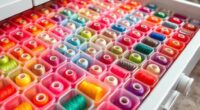



![[NEW] Sewing Machine Thread Tension Regulator Set - Household Accessory](https://m.media-amazon.com/images/I/31sLF9yK58L._SL500_.jpg)



